|
|
|
Sort Order |
|
|
|
Items / Page
|
|
|
|
|
|
|
| Srl | Item |
| 1 |
ID:
151062
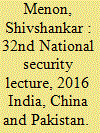

|
|
|
| 2 |
ID:
151067
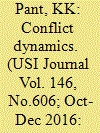

|
|
|
|
|
| Summary/Abstract |
Conflicts happen, leaving tangled stomachs, crumpled brows, shaky knees. They strain us and stretch us. To address conflicts constructively, we need intuition and imagination to navigate the shades of conflict. In this article, I wish to examine the dynamics of conflict process. Conflicts do not arise simply because of differences over issues or miscommunication. Some of the most difficult conflicts, we face today have well-defined issues and have been the subject of countless efforts at calm communications. In the words of Bo Kjellen, the Swedish negotiator to the Kyoto Protocol, “I only knew negotiations through my practical experience and started to read the theory only towards the end of my career. I think it would have helped me a lot had I known the theory earlier”.
|
|
|
|
|
|
|
|
|
|
|
|
|
|
|
|
| 3 |
ID:
151064


|
|
|
|
|
| Summary/Abstract |
Sitting strategically astride one of the busiest and most critical shipping lanes of the world, there is no place better than Galle in Sri Lanka, to brainstorm about the Oceans. There was a time when oceans were deemed barriers between land masses. That paradigm has shifted to view oceans as connectors of land masses. This has been made possible by maritime transportation offering economies of scale that far surpasses what is possible on continent; an edge that has only grown with passage of time.
|
|
|
|
|
|
|
|
|
|
|
|
|
|
|
|
| 4 |
ID:
151066
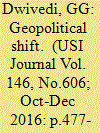

|
|
|
|
|
| Summary/Abstract |
In his book ‘World Order’, Henry Kissinger identifies four great world orders in history: European, Islamic, Chinese and American; each shaping the destiny of their nations, regions and the world at large as per respective agendas. While Europeans strived for bringing about balance in the international affairs; Islamic states pursued expansion; Chinese sought tributes to the Emperor; America perceived itself as the beacon to the world for universal values. While true world order has never existed, what prevailed over a period was devised at Westphalia almost four centuries back.
|
|
|
|
|
|
|
|
|
|
|
|
|
|
|
|
| 5 |
ID:
151070


|
|
|
|
|
| Summary/Abstract |
During the period under review (October- December), a number of activities were undertaken by the Centre for Armed Forces Historical Research (CAFHR), as part of its two main projects: The Joint USI-MEA ‘India and the Great War Centenary Commemoration’ Project, which began in 2014 and the ‘India Remembers’ Project which was launched on 14th July 2016.
On 19th October, a one-day symposium titled ‘Meeting of the Minds II’ was held in London, UK. The symposium was jointly organised by the USI-CAFHR, the Imperial War Museum (IWM), the Royal Pavilion & Museums, Brighton & Hove and the Golden Tours Foundation (GTF).
|
|
|
|
|
|
|
|
|
|
|
|
|
|
|
|
| 6 |
ID:
151063
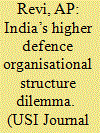

|
|
|
|
|
| Summary/Abstract |
The present Higher Defence Management (HDM) structure in India is a product of partial and half-hearted implementation of the Cabinet Committee on Security (CCS) decision of 2002. The Chief of Defence Staff (CDS), a crucial element, remains unfulfilled, jointness/integration is a distant dream and the military vs. bureaucracy confrontation issue stands unaddressed.1 This paper attempts to analyse the prevailing situation and suggests a way forward.
|
|
|
|
|
|
|
|
|
|
|
|
|
|
|
|
| 7 |
ID:
151068


|
|
|
|
|
| Summary/Abstract |
Encapsulated by the phrase “junwei guanzong, zhanqu zhuzhan, junzhong zhujian” (overall management by the Central Military Commission (CMC), operational focus by theatres and force building by service headquarters), the recent PLA organisational reforms have been more ambitious than anticipated. Broadly covering higher defence reorganisation, tighter Party and CMC control, downsizing and joint operation requirements, the reforms have also led to the reorganisation of the seven Military Regions (MRs) to five theatre commands. This article links the PLA theoretical military writings to the reorganisation of the theatre commands to understand the rationale for the reorganisation. The article primarily uses PLA Academy of Military Science publications, The Science of Military Strategy 2005 (hereafter referred to as SOS 2005) available in English and the Zhanlue Xue 2013 (hereafter referred to as ZX 2013), available as of now in Chinese.
|
|
|
|
|
|
|
|
|
|
|
|
|
|
|
|
| 8 |
ID:
151069


|
|
|
|
|
| Summary/Abstract |
Mountain artillery batteries are a fascinating study of the Indian Army during the colonial period. Even in English literature, mountain gunners or the pack artillery has been eulogised in the famous poem ‘Screw-Guns’ by Rudyard Kipling:
“Smokin’ my pipe on the mountings, snifin’ the mornin’ cool,
I walks in my old brown gaiters along o’ my old brown mule….”
Regular artillery companies had been approved by the East India Company in 1748 for the three Presidency Armies of Bengal, Madras and Bombay. Before the First War of Independence (called Great Indian Mutiny of 1857 by the British or the rebellion), ‘‘the Company’s artillery consisted of mountain units, the horse artillery and the somewhat curiously termed ‘foot’ artillery (field gunners). The last two were made of British and Indians, but the new mountain trains consisted of Indians only under a British commanding officer.1 The First War of Independence or the rebellion ‘saw almost the entire Bengal native artillery rise in arms except the newly raised mountain trains and the horse field batteries employed on the frontier.’2 Post 1857 till outbreak of the war, only 12 mountain pack batteries were entrusted to Indian units for action in the tribal belt against insurgents in the northwest of India.
|
|
|
|
|
|
|
|
|
|
|
|
|
|
|
|
| 9 |
ID:
151065
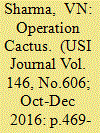

|
|
|
|
|
| Summary/Abstract |
It was 0815 hours, on a fine 3rd November 1988 morning. The RAX secret telephone was ringing urgently in my bedroom as I was about to leave Army House for my office at the South Block. It was Ronen Sen (later our ambassador to the USA), the young and friendly foreign-service officer at Prime Minister Rajiv Gandhi’s office (the PMO). Our conversation went somewhat like this
|
|
|
|
|
|
|
|
|
|
|
|
|
|
|
|
|
|
|
|
|